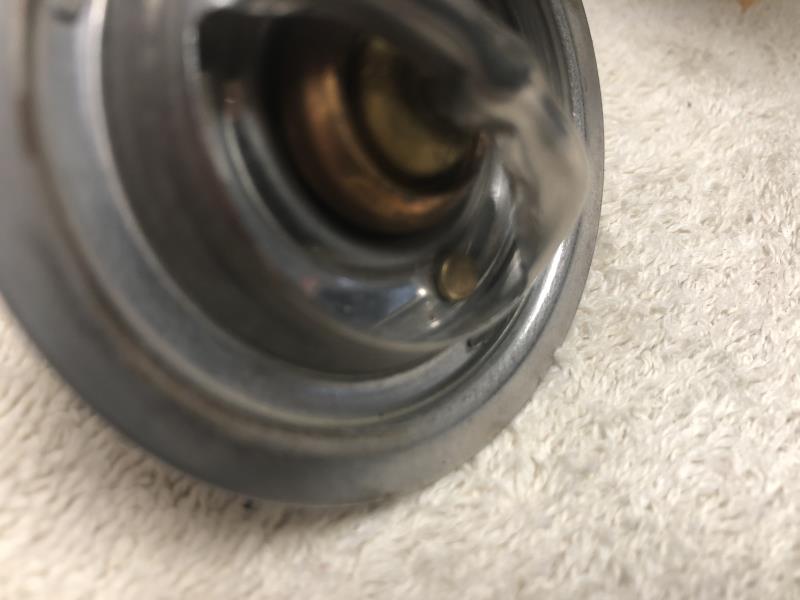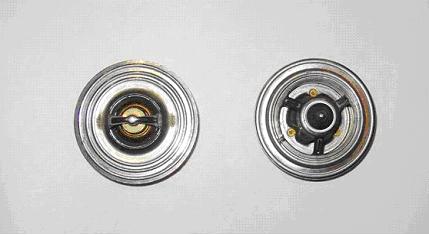|
By DryLakesRacer - 5 Years Ago
|
Even tho it says it, I believe thermostat is not sticking and in a pan of hot water it never fails. What I have 292 Edelbrock dual quad manifold, Vacuum heated control. 170* high flow thermostat.
The vacuum heater control valve on an Edelbrock manifold is closer to the thermostat than on a stock intake. I believe the extension on a vacuum valve hits or interferes with the action of the thermostat spring at times, It seem to be a problem when cold on first start-up more than after it has ran.
Has anyone else had this problem or do you see any reason to not remove or shorten the extension on the the heater valve which protrudes into the area of the the thermostat. The extension screws into the valve body. A non high flow is smaller in diameter at the spring but I've fought a cooling problem for years and it seems to be fixed and I don't really want to change the high flow back to standard.
Cooling fixes include: 5 blade fan, radiator shroud, plug in bypass with 1/8" hole, and smaller water pump pulley. Open for suggestions.. Thanks
|
|
By 55blacktie - 5 Years Ago
|
|
Wanting to eliminate vacuum lines, I'm switching to a manual heater control valve and electric wipers. The manual heater control kit is less than $100, and it's an easy installation. My kit came with no instructions, but I was able to get them, including photos, from another source. A new vacuum heater control valve costs more than the manual conversion, and they have been known to fail.
|
|
By DryLakesRacer - 5 Years Ago
|
I can understand what your saying. 7 years ago i had a vacuum one fail. I've converted to Newport wipers but at this time I don't want to add any more cables under the hood or dash.
Not sure on the 55 but if you start having a problem installing the Newport electric motor; after struggling for an hour to put in the new attaching screws on my 56 stock brackets, I used 2 longer 10-32 screws from the top down as studs, took 2 10-32 nuts from my stash and had it in 2 minutes. They work great....
|
|
By miker - 5 Years Ago
|
55blacktie, FWIW. If you got one of these from the T bird guys check it first. They say it only works one way, but I've had several that leak if the engine rpm goes over about 3000. Big blast of hot air and it takes forever to blow out of the heater.
I couldn't get the picture to copy, here's a link to the typical one.
https://www.napaonline.com/en/p/TEM935813?cid=paidsearch_shopping_dcoe_google&gclid=EAIaIQobChMI3oCi49vD6wIVEz6tBh01kgAqEAQYBSABEgKjDPD_BwE
|
|
By paul2748 - 5 Years Ago
|
I haven't had the problem. but I have heard from others that the heater control or any other piece (like an elbow if using a inline control) in the intake can interfere with the operation of the thermostat. I would check this out .
Another thing I have found out using the plug in the by-pass hose - on initial warm up it will cause the water to get very hot before the thermostat opens.(and will peg the gauge). Once the thermostat opens, it's ok. With the plug, you should be using the special thermostat with extra holes to allow for some coolant to flow.
tDryLakesRacer (8/30/2020)
Has anyone else had this problem or do you see any reason to not remove or shorten the extension on the the heater valve which protrudes into the area of the the thermostat. The extension screws into the valve body. A non high flow is smaller in diameter at the spring but I've fought a cooling problem for years and it seems to be fixed and I don't really want to change the high flow back to standard. Cooling fixes include: 5 blade fan, radiator shroud, plug in bypass with 1/8" hole, and smaller water pump pulley. Open for suggestions.. Thanks
|
|
By DryLakesRacer - 5 Years Ago
|
Thanks Paul. I have 1/8” hole in the bypass plug to assure there is some flow or circulation of water in the block during warmups none however goes through to radiator with it either open or plugged with a hole.
The thermostat has a flat area where there is a small diameter hole with a device for doing the same thing. Over the years I have drilled 2-3 extra holes on the flat area of thermostats but not on this one. Photos show the internal flapper (both sides) to insure some flow thru the radiator.  
|
|
By 55blacktie - 5 Years Ago
|
|
Thanks for the tip. Fortunately, I've removed the seat for new upholstery, so I have more space to work in. I'm not a big guy, but I am claustrophobic. I don't like working underneath the car either, but I can't afford to pay someone else to do it. Even if I could, I have a problem paying for something I can do myself. If I screw up, I have only myself to blame, but my wife will say otherwise.
|
|
By 55blacktie - 5 Years Ago
|
|
Yep, mine came from Tbird supplier, but the housing is plastic. I don't know if that's good or bad. Better it's in the engine compartment.
|
|
By DryLakesRacer - 5 Years Ago
|
55. I was 75 when I put mine in. I unbolted the seat and moved it back against the rear seat. My wife was in the back seat to hand me tools I’d set on the front seat. My radio was out getting converted to am/fm/blue tooth. I laid on my back with a milk crate next to the open door with a moving pad on it for more support.
She is always my helping hand since our kids moved away. She helps with all the brake bleeding both for the 8.8 I put in the rear and the Wilwood disc kit I put on the front. When our kids were real young she worked the floor jack when I put transmissions in our race car... stuck with me 54 year so far...
|
|
By GREENBIRD56 - 5 Years Ago
|
Its been a while since I visited the Stewart Components site so I don't know what they currently offer for a "ventilated" high flow thermostat. In the past they drilled some free flow holes in their offerings so that the thermostat was not a total seal when closed - a controlled leak as it were. I know they were offering the "Robert Shaw" type of poppet but the other types should work too.
These two t-stats fit the same opening but have way different flow ratings. But even the large port variety has room for some "owner drilled" relief holes -1/8 or 5/32 drill bit? Rather than deadhead the cooling circuit it allows water flow toward the operating "pill" that then pulls the poppet open. When combined with the small orifice hole in the bypass plug - a fair amount of water can move. You may have to add one or more to make yours have a better "leak rate".
|
|
By DryLakesRacer - 5 Years Ago
|
Thanks Greenbird. I can see where they call the one I have “ventilated” and how it works with the water pressure from inside the intake allowing it to open and flow a slight amount of the hot water into the upper hose while the sensor on the thermostat heats up to properly actuate.
Are you saying I should add a 1/8” or so hole or two next to the poppet part or to the outer rim for extra flow? I can understand this as years ago I did this on other engines. Your ideas in the past are what solved my cooling problems.
|
|
By Joe-JDC - 5 Years Ago
|
|
Typically a hole was added only to allow air to escape and not get an airlock upon start-up after a water pump change, or a rebuild of the engine. Joe-JDC
|
|
By GREENBIRD56 - 5 Years Ago
|
|
DLRacer - Yes - add a 1/8 hole or two to get water moving in the direction of the Radiator. As you may know, every time we hear of people with "hot spots" due to partially blocking the bypass - they typically have not provided another way for the water to move toward the t-stat / radiator. As someone mentioned, the little holes put in the commercial t-stats - is there for air passage, not for the viscosity of water. You need more of a passageway to create the altered waterflow arrangement..
|
|
By DryLakesRacer - 5 Years Ago
|
I went thru my stash and had a Robert Shaw FlowCooler style 160. I believe I removed it when I added the dual quads and the heater controller hit it. I removed the controllers extension and cut about 3/4” off it bringing it back to even with the thermostat hole in the manifold. I drilled 3 small holes in the circular crown of the thermostat housing. Replaced the coolant and ran the engine in drive with the radiator blocked with cardboard. I left the cap off and watched for movement of the water.
In drive idling, when my electronic digital thermometer aimed at the thermostat housing showed 162* there was movement of water across the radiator looking through the open cap. The temp gauge shows about 3/8” up the line and it never indicated that it stuck at all. Just went up from cold to whatever the run temp will be. I’ll know more when I drive it tomorrow.
Thanks to every one who responded. I am convinced the other style thermostat was hitting the heater valve.
|
|
By DryLakesRacer - 5 Years Ago
|
|
Took the car out and the temp gauge worked perfectly. Did not go high like the thermostat was stuck. I am sure the spring style thermostat was hitting the heater control valve extension. With the extension cut shorter the Robert Shaw Flow Cool thermostat fit. I should have looked a lot closer when I installed the Edelbrock manifold.
|
|
By GREENBIRD56 - 5 Years Ago
|
Seems to me that my experience with those high flow thermostats - Robert Shaw type in particular from Mr. Gasket - was that the 160º version worked fine (with the drilled ports added). But........... when I tried the same thing in a 180º version it was poor quality and failed. Back to the 160º and things worked OK, but I was hoping to get the warmer running temp for cooler weather. I think Charlie had a similar experience - the 180º version just wasn't a reliable part.
My engine with the mods you were talking about - bypass orifice, small pulley, more fan blades and so forth - seems to want to run about 100º over ambient (small T-bird radiator and the goofy 1" spacer behind the water pump). Rather than going all the way down to a 160º water temp in winter - the 180º would be preferable.
|